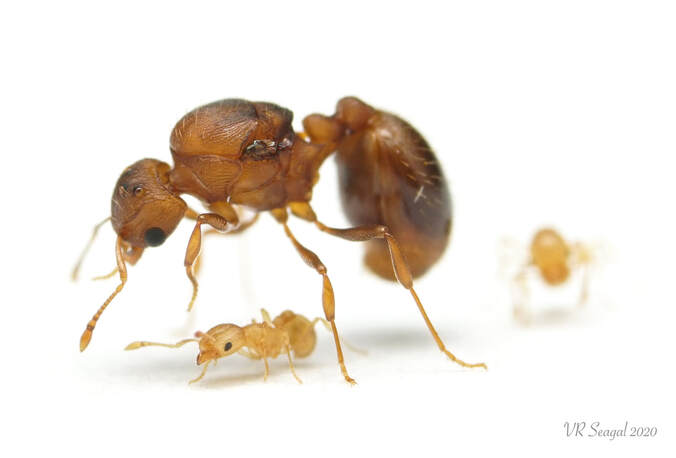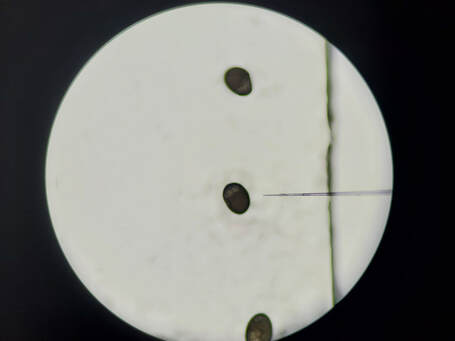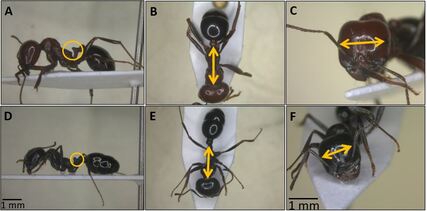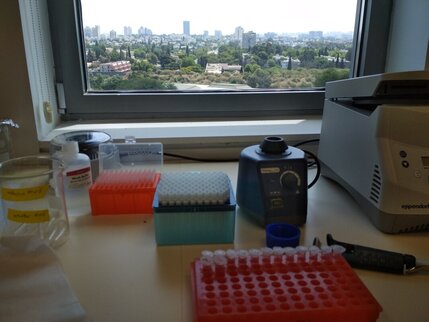Genetic engineering of little fire antsInvasive ant species are an increasing burden on local ecology and human economy. The olfactory system in supercolony-creating ant species might be wired slightly different to avoid intraspecific aggression, maintain the population structure and gain (at least) short-term ecological success. I am exploring this direction, while taking advantage of recent emergence of genetic and genomic tools to gain further insight and in order to develop novel management methods in the little fire ant (Wasmannia auropunctata). This project is carried out with Dr. Hua Yan in the Biology Department, at the University of Florida. |
|
Invasion history & social structure of the little fire ant in floridaThe little fire ant (W. auropunctata) is an environmental and agricultural invasive pest on a global scale. This species was first documented in Florida and in the USA in 1924, and despite its long-established invasion, its population structure and invasion history have been poorly studied. Invasive populations of W. auropunctata are mainly supercolonial. It is not clear if Florida populations represent closely-related expansions of a single or of multiple supercolonies. Therefore, I am collecting W. auropunctata colonies throughout Florida, conducting behavioral essays and corresponding molecular analysis to better understand the distribution, social structure, and history of W. auropunctata, and to plan for its likely spread throughout the South-eastern USA. Understanding the history and status of W. auropunctata now, may also aid in preventing future introductions into USA. This project is conducted with Dr. Andrea Lucky, from the Entomology and Nematology Department in the University of Florida, and is funded by the USDA. |
My talk at the Entomological Society of America, CO, 2021 on:
-Where did the invasive little fire ant spread to in Florida? -Hints to her social structure. |
Assessing colony size in wild desert antsCataglyphis niger is a native species- endemic to Israel. Generally- excavating colonies of ants to extract their size is daunting, unhealthy to habitats, and it may prevent long-term research, including testing seasonal effects on colony size. Previous capture-recapture methods that avoid excavating colonies have been proven inefficient when sampling ants. I therefore offer here a simple method to estimate the colony size of Cataglyphis niger in a field setting. I also demonstrate seasonal effects on colony size and foraging activity. This study should be useful for further ecological studies as Cataglyphis ants are scavengers, who contribute immensely to their habitat. Estimating ant population without harming it, may be of use to assess the habitat capacity to carry these precious scavenger ants. The video on the right is a related talk I gave in ABS virtual meeting 2020.
Relevant Prepring |
|
Revising the taxonomic status of Israeli harvester antsHarvester ants are considered to be ecosystem engineers. They impact their habitat by preying and distributing seeds and plant material. In Israel, the role of the Messor harvester ant genus in local ecology is prominent, especially in desert habitats, where plant material is meager. But the taxonomic status of many species of Messor in the Mediterranean region is currently lacking. This project aimed to conduct extensive collections of Messor species throughout Israel, and perform the first thorough molecular and ecological analyses in order to clarify the taxonomic status of the Israeli Messor species and their respective ecological niches. This project is carried out with Dr. Netta Dorchin, Dr. Roi Dor & Dr. Tali Magory Cohen, the Steinhardt Museum of Natural History and Tel-Aviv University, and with Dr. Pierre-Andre Eyer, Texas A&M University. Relevant Preprint |




